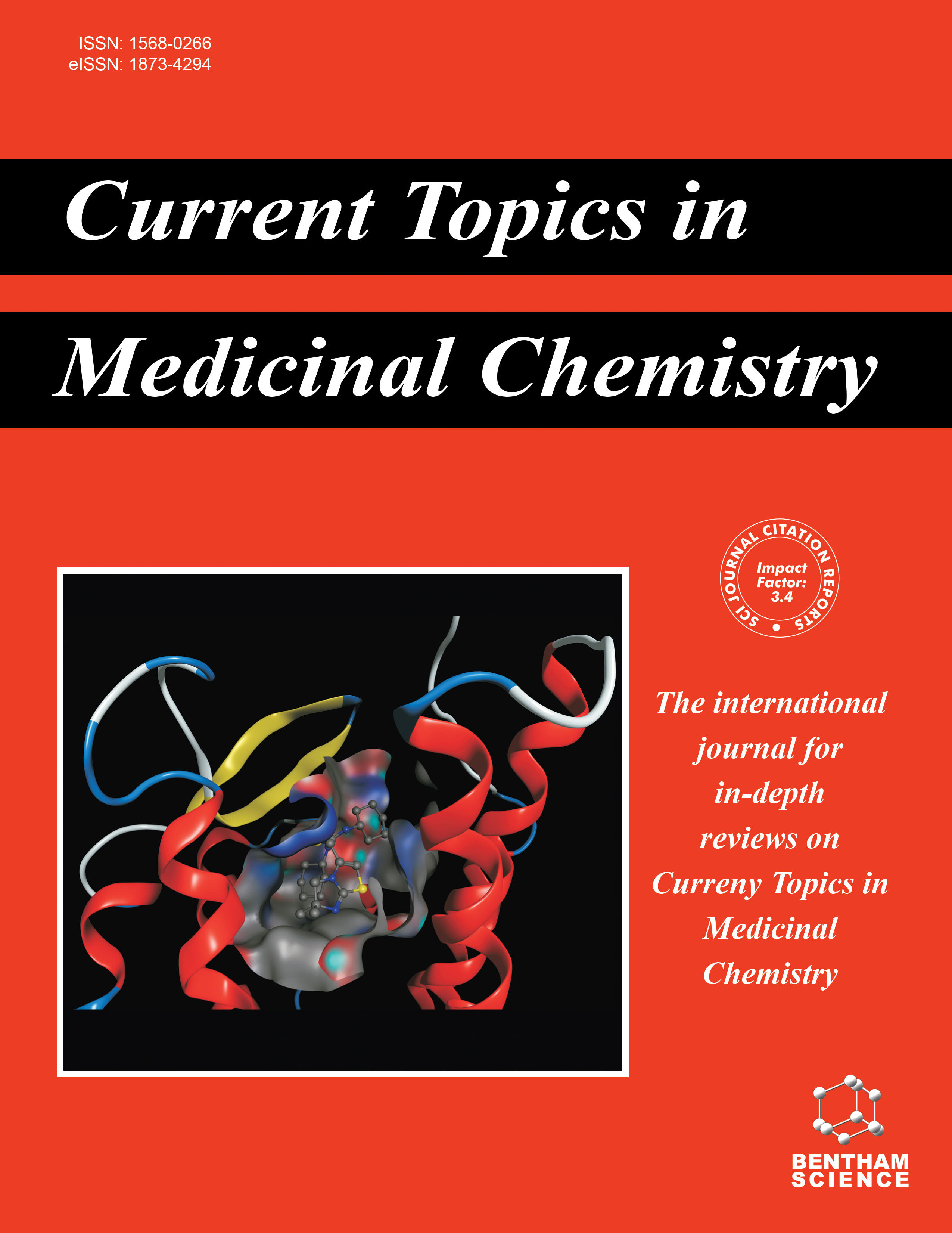- Home
- A-Z Publications
- Current Topics in Medicinal Chemistry
- Previous Issues
- Volume 16, Issue 28, 2016
Current Topics in Medicinal Chemistry - Volume 16, Issue 28, 2016
Volume 16, Issue 28, 2016
-
-
The Chemistry and Bio-Medicinal Significance of Pyrimidines & Condensed Pyrimidines
More LessThis review discusses the biological and medicinal significance of one of the most important and interesting heterocyclic ring systems, the pyrimidine and its condensed derivatives. Herein, various physiologically important molecules, as well as, therapeutically used drugs having a pyrimidine or condensed pyrimidine system in their chemical structures, have been covered. The chemistry and synthesis of pyrimidines Read More
-
-
-
Pyrimidine-fused Derivatives: Synthetic Strategies and Medicinal Attributes
More LessAuthors: Gaurav Joshi, Himanshu Nayyar, Jimi Marin Alex, Gajendra S. Vishwakarma, Sunil Mittal and Raj KumarPyrimidine-fused derivatives traits the inextricable part of DNA and RNA, exhibit indispensable role in numerous biological processes, possessing momentous chemical and biological importance. Pyrimidine-condensed derivatives as the pharmacophore exhibit broad spectrum of biological activities encompassing antitubercular, antibacterial, antifungal, antiviral, anti-inflammatory, antimalarial, anticancer and anti-HIV. Seve Read More
-
-
-
Exploring Pyrimidine Pharmacophore as Thymidine Monophosphate Kinase Inhibitors for Antitubercular Activity: A Review
More LessTuberculosis (TB) has been declared as a health emergency due to emergence of resistant strains of M. tuberculosis, multidrug resistant (MDR), extensively drug resistant (XDR) TB strains and totally drug resistant tuberculosis (TDR-TB) reported recently in some parts of the world. Therefore, the current situation necessitates developing new antitubercular agents acting on novel targets for effectively controlling TB. Thymidine Read More
-
-
-
Pyrazolo[4,3-e][1,2,4]triazolo[1,5-c]pyrimidines and Structurally Simplified Analogs. Chemistry and SAR Profile as Adenosine Receptor Antagonists
More LessAdenosine was defined as a neuromodulator which exerts its action by interaction with specific G-protein coupled receptor termed adenosine receptors. Adenosine receptors are expressed in several tissues and cells of our body and exist as four different subtypes of these receptors: A1, A2A, A2B and A3. In the last years significant efforts were made to obtain highly potent and selective ligands for the four adenosine rece Read More
-
-
-
Chemistry and Bioactivities of Aristeromycins: An Overview
More LessAuthors: Ravindra K. Rawal, Jitender Bariwal and Virender SinghThe majority of carbocyclic nucleosides are of synthetic origin; nature has provided two of the most interesting compounds, aristeromycin and neplanocin A. Aristeromycin and its modified derivatives are an important group of carbocyclic nucleosides that exhibits a wide range of pharmacological properties such as antiviral, anticancer and antitoxoplasma activities. Especially, aristeromycins are widely used as anti Read More
-
-
-
Pyridines and Imidazopyridines with Medicinal Significance
More LessPyridine and pyridine-fused ring systems are ubiquitous in medicinal research and demonstrate such diverse pharmacological benefits as anticonvulsant therapies, treatment for fungal and bacterial infections as well as chemotherapy agents. For example, imidazo[1,2-a]pyridines have exhibited a broad range of activity as antiviral, antibacterial, analgesic, antipyretic, and antiinflammatory agents. Indeed many advance Read More
-
-
-
Heterocyclic Naphthalimides as New Skeleton Structure of Compounds with Increasingly Expanding Relational Medicinal Applications
More LessAuthors: Huo-Hui Gong, Dinesh Addla, Jing-Song Lv and Cheng-He ZhouNaphthalimide compounds are an important type of nitrogen-containing aromatic heterocycles with cyclic double imides and the naphthalene framework. This π-deficient large conjugated planar structure enables naphthalimide derivatives to readily interact with various biological cations, anions, small molecules and macromolecules such as DNAs, enzymes and recetors in living organism via noncovalent bonds, therefore Read More
-
-
-
Matrine: Bioactivities and Structural Modifications
More LessAuthors: Jiulin Huang and Hui XuMatrine is a quinolizidine alkaloid isolated from the roots of Sophora flavescens (Kushen), Sophora tonkinensis, and Sophora alopecuroides (Kudouzi). Matrine and its derivatives have displayed a broad scope of biological properties such as anticancer activity, anti-inflammatory activity, antiviral activity, analgesic effect, anti-fibrotic activity, insecticidal activity, antimicrobial activity, etc. The present review has summarize Read More
-
Volumes & issues
-
Volume 25 (2025)
-
Volume 24 (2024)
-
Volume 23 (2023)
-
Volume 22 (2022)
-
Volume 21 (2021)
-
Volume 20 (2020)
-
Volume 19 (2019)
-
Volume 18 (2018)
-
Volume 17 (2017)
-
Volume 16 (2016)
-
Volume 15 (2015)
-
Volume 14 (2014)
-
Volume 13 (2013)
-
Volume 12 (2012)
-
Volume 11 (2011)
-
Volume 10 (2010)
-
Volume 9 (2009)
-
Volume 8 (2008)
-
Volume 7 (2007)
-
Volume 6 (2006)
-
Volume 5 (2005)
-
Volume 4 (2004)
-
Volume 3 (2003)
-
Volume 2 (2002)
-
Volume 1 (2001)
Most Read This Month
Article
content/journals/ctmc
Journal
10
5
false
en


